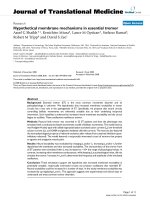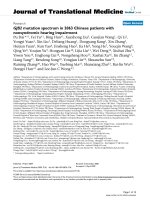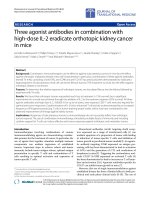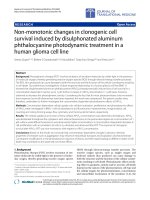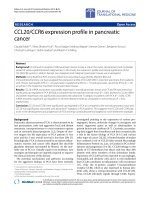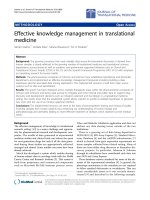Báo cáo hóa học: " CCL20/CCR6 expression profile in pancreatic cancer" docx
Bạn đang xem bản rút gọn của tài liệu. Xem và tải ngay bản đầy đủ của tài liệu tại đây (827.28 KB, 8 trang )
Rubie et al. Journal of Translational Medicine 2010, 8:45
/>Open Access
RESEARCH
BioMed Central
© 2010 Rubie et al; licensee BioMed Central Ltd. This is an Open Access article distributed under the terms of the Creative Commons
Attribution License ( which permits unrestricted use, distribution, and reproduction in
any medium, provided the original work is properly cited.
Research
CCL20/CCR6 expression profile in pancreatic
cancer
Claudia Rubie*
†1
, Vilma Oliveira Frick
†1
, Pirus Ghadjar
3
, Mathias Wagner
2
, Henner Grimm
1
, Benjamin Vicinus
1
,
Christoph Justinger
1
, Stefan Graeber
4
and Martin K Schilling
Abstract
Background: CCL20 and its receptor CCR6 have been shown to play a role in the onset, development and metastatic
spread of various gastrointestinal malignancies. In this study, the expression profile and clinical significance of the
CCL20/CCR6 system in distinct benign, pre-malignant and malignant pancreatic tissues was investigated.
Methods: Using RealTime-PCR, enzyme-linked immunosorbent assay (ELISA), Western Blot and
immunohistochemistry, we have analyzed the expression profile of CCL20/CCR6 in resection specimens from patients
with chronic pancreatitis (CP) (n = 22), pancreatic cystadenoma (PA) (n = 11) and pancreatic carcinoma (PCA) (n = 25)
as well as in the respective matched normal pancreatic tissues.
Results: CCL20 mRNA and protein was weakly expressed in normal pancreatic tissues and CP and PA specimens but
significantly up-regulated in PCA (8-fold) as compared to the matched normal tissue (P < 0.05). Moreover, CCL20 mRNA
and protein expression was significantly associated with advanced T-category in patients with PCA (P < 0.05). CCR6
mRNA showed a significant up-regulation in all three disease entities as compared to normal tissues (P < 0.05,
respectively).
Conclusion: CCL20 and CCR6 were significantly up-regulated in PCA as compared to the normal pancreatic tissue and
CCL20 was significantly associated with advanced T-category in PCA patients. This suggests that CCL20 and CCR6 play
a role in the development and progression of PCA and may constitute potential targets for novel treatment strategies.
Background
Pancreatic adenocarcinoma (PCA) is characterized by its
late presentation, early and aggressive local and distant
metastasis, unresponsiveness to most treatment options
and an extremely dismal prognosis [1,2]. Despite of cura-
tive surgery the life expectancy of PCA patients is very
poor and the 5-year overall survival is less than 20% [3].
Histologically, PCA is characterized by an intense inflam-
matory reaction and cancer cells shaped like duct-like
glandular elements surrounded by fibrosis. As the mor-
tality rate of PCA is virtually equal to its incidence, new
strategies and therapies are urgently required to improve
the clinical outcome of this disease.
The potential mechanisms and pathways accounting
for the aggressive biology of PCA have been intensely
investigated pointing to the expression of various pro-
angiogenic factors, molecular changes in oncogenes and
tumor suppressor genes as well as abnormalities in
growth factors and cytokines [4-7]. Currently, accumulat-
ing data suggest that chemokines and their receptors play
a role in the tumor biology of PCA [8-11] and various
other types of cancer [12,13]. A limited number of studies
have outlined a role of CCL20 (also termed Macrophage
Inflammatory Protein-3α, Larc, or Exodus) in PCA devel-
opment and progression [14-16]. CCL20 belongs to the
family of CC-chemokines but shares only less than 30%
identity with other members of this chemokine family.
Expression of CCL20 has been reported in macrophages,
eosinophils and dendritic cells and it is well established
that CCL20 contributes to inflammatory cell recruitment
[17]. Only the G-protein coupled 7-transmembrane
receptor CCR6, which is also expressed in human den-
dritic cells, shows a strong interaction with CCL20 [18].
Thus, CCL20 selectively signals through CCR6. Expres-
* Correspondence:
1
Dept. of General -, Visceral-, Vascular - and Paediatric Surgery, University of the
Saarland, 66421 Homburg/Saar, Germany
†
Contributed equally
Full list of author information is available at the end of the article
Rubie et al. Journal of Translational Medicine 2010, 8:45
/>Page 2 of 8
sion of CCL20 has been confirmed in various human can-
cer entities, such as leukaemia, lymphoma, melanoma,
hepatocellular carcinoma, prostate cancer, colorectal ade-
nocarcinoma and lung and oral squamous cell carcinoma
[19-22]. Moreover, expression of the CCL20/CCR6 sys-
tem has been reported in PCA tissues and pancreatic
cancer cell lines. Stimulation of the CCR6 bearing PCA
cells with CCL20 led to an increased proliferation, migra-
tion and invasion and it was postulated that CCL20 may
act via autocrine and paracrine mechanisms to contribute
to the pathobiology of human PCA [14-16]. Recent stud-
ies demonstrated that CCL20 may promote pancreatic
tumor cell migration and invasion through the up-regula-
tion of matrix metalloproteinase production [16].
Here, we comparatively investigated the expression
profile and clinical significance of the CCL20/CCR6 sys-
tem in PCA as well as in chronic pancreatitis (CP) and
pancreatic cystadenoma (PA) which represent pre-malig-
nant conditions often preceding the development of
PCA. Essentially, we report significant CCL20/CCR6 up-
regulation in PCA tissues compared to matched normal
pancreatic tissues. In addition, we detected a significant
correlation of CCL20 expression with advanced T-cate-
gory in PCA patients suggesting an involvement of
CCL20/CCR6 in the development and progression of
PCA.
Methods
Materials
Surgical specimens and corresponding normal tissue
from the same samples were collected from patients who
underwent surgical resection at our department between
2002 and 2008.
Informed written consent for tissue procurement was
obtained from all patients and the study was approved by
the local ethics commission of the Ärztekammer des
Saarlandes.
Fifty-eight patients were enclosed in the study, consist-
ing of patients with primary ductal PCA (n = 25), CP (n =
22) and PA (n = 11). In every patient sample the corre-
sponding non-affected normal pancreatic tissue was also
analyzed, thus the total sample size was 116. Of the 25
patients with cancer one cancer was classified as pT1, six
as pT2, fifteen as pT3 and three as pT4, with positive
nodal involvement in 17 cases, according to the UICC
TNM classification [23]. No patient had received any
kind of neoadjuvant therapy prior to resection. The clini-
cal data and patient characteristics for the different pre-
malignant and malignant entities were obtained from a
prospective database and are summarized in table 1 and
table 2.
Tissue preparation
Tissue specimens were collected immediately after surgi-
cal resection, snap frozen in liquid nitrogen and then
stored at -80°C until they were processed under nucleic
acid sterile conditions for protein extraction. For corre-
sponding normal tissue we used adjacent non-affected
tissue from the same resected specimens. All tissues
obtained were reviewed by an experienced pathologist
and examined for the presence of tumor cells. As mini-
mum criteria for usefulness for our study, we only used
tumor tissues in which tumor cells constituted at least >
70% of the tumor biopsy.
Single-strand cDNA synthesis
Total RNA was isolated using RNeasy columns from Qia-
gen (Hilden, Germany) according to the manufacturer's
instructions. RNA integrity was confirmed spectrophoto-
metrically and by electrophoresis on 1% agarose gels. For
cDNA synthesis 5 μg of each patient total RNA sample
were reverse-transcribed in a final reaction volume of 50
μL containing 1× TaqMan RT buffer, 2.5 μM/L random
hexamers, 500 μM/L each dNTP, 5.5 mM/L MgCl
2
, 0.4 U/
μl RNase inhibitor, and 1.25 U/μL Multiscribe RT. All RT-
PCR reagents were purchased from Applied Biosystems
(Foster City, CA). The reaction conditions were 10 min at
25°C, 30 min at 48°C, and 5 min at 95°C.
Real-time PCR
All Q-RT PCR assays containing the primer and probe
mix were purchased from Applied Biosystems, (Applied
Biosystems, Foster City, CA) and utilized according to the
manufacturer's instructions. PCR reactions were carried
out using 10 μL 2× Taqman PCR Universal Master Mix
No AmpErase
®
UNG and 1 μL gene assay (Applied Biosys-
tems, Foster City, CA), 8 μL Rnase-free water and 1 μL
cDNA template (50 mg/L). The theoretical basis of the
qRT assays is described in detail elsewhere [24]. All reac-
tions were run in duplicates along with no template con-
trols and an additional reaction in which reverse
transcriptase was omitted to assure absence of genomic
DNA contamination in each RNA sample. For the signal
detection, ABI Prism 7900 sequence detector was pro-
grammed to an initial step of 10 min at 95°C, followed by
40 thermal cycles of 15 s at 95°C and 10 min at 60°C and
the log-linear phase of amplification was monitored to
obtain C
T
values for each RNA sample.
Gene expression of all target genes was analyzed in
relation to the levels of the slope matched housekeeping
genes phosphomannomutase (PMM1) and cyclophilin C
(CycC) [25]. Analysis was performed using the delta CT
method and samples were normalized to the control tis-
sue sample. Hence, the normal tissue became the 1 ×
sample, and all other quantities were expressed as an n-
fold difference relative to this tissue.
Isolation of total protein
Protein lysates from frozen tissue were extracted with the
radioimmunoprecipitation (RIPA) buffer containing
Rubie et al. Journal of Translational Medicine 2010, 8:45
/>Page 3 of 8
Complete, a protease inhibitor cocktail (Roche, Penzberg,
Germany). Total protein quantification was performed
using the Pierce BCA protein assay reagent kit (Pierce,
Rockford, Ill., USA).
Sandwich-Type Enzyme-Linked Immunosorbent Assay
The chemokine protein levels in the different tissue
lysates were determined by sandwich-type enzyme-
linked immunosorbent assays (ELISA) according to the
manufacturer's instructions. Samples were assayed in
duplicate with all values calculated as the mean of the two
measurements. CCL20 levels were assayed using a vali-
dated commercial ELISA (Duo Set R&D Systems, DY360,
Minneapolis, Minn., USA). The absorbance was read at
450 nm in a 96-well microtiter plate reader. The
chemokine concentration from each tissue lysate was
normalized to the total protein content of each sample.
Immunohistochemistry
Operative specimens were routinely fixed in formalin and
subsequently embedded in paraffin. Before staining, 4-
μm thick paraffin-embedded tissue section were
mounted on Superfrost Plus slides, deparaffinized and
rehydrated in graded ethanol to deionized water. The sec-
tions were microwaved with an antigen retrieval solution
(Target Retrieval, Dakocytomation, Carpinteria, CA,
USA) and after blocking of endogenous peroxidase activ-
ity with 3% hydrogen peroxide, the sections were further
blocked for 30 min at room temperature with normal rab-
bit serum. Overnight incubation at 4°C with primary goat
polyclonal anti-human CCL20 antibody (15 μg/ml,
AF254, R&D Systems, Minneapolis, Minn., USA) was fol-
lowed by incubation of secondary biotinylated rabbit
anti-goat IgG antibody and the avidin-biotin-peroxidase
reaction (Vectastain ABC ELITE Kit, Vector Laborato-
ries, Burlingame, CA, USA). After colour reaction with
aminoethylcarbazide solution (Merck, Darmstadt, Ger-
many), tissues were counterstained with haematoxylin.
Negative controls were performed in all cases omitting
primary antibody.
Western Blot Analysis
Total protein (25 μg/lane) was separated by SDS-PAGE
using a 10% gel and blotted onto nitrocellulose mem-
branes (Hybond ECL, Amersham Biosciences, Piscat-
away, NJ, USA). Membranes were blocked by incubation
in Tris-buffered saline (TBS) containing 5% nonfat dry
milk and 0.1% Tween 20 for 2 h at room temperature and
then incubated overnight at 4°C with goat anti-human
CCR6 antibody (diluted 1:500, C2099-70B, Biomol, Ham-
burg, Germany). Blots were then washed and incubated
at room temperature for 1 h with donkey anti-goat HRP
antibody (diluted 1:5000, sc-2056, Santa Cruz Biotech-
nology, Santa Cruz, CA USA). Bands were visualized by
ECL Western blotting analysis systems (Amersham Bio-
sciences, Piscataway, NJ, USA). The human cell lysate
HL-60 (sc-2209, Santa Cruz Biotechnology, Santa Cruz,
CA, USA) served as positive control. Quantification of
figure four has been performed on three independent
samples using image J software.
Calculations and Statistical Analysis
All chemokine concentrations are presented as mean and
SEM (standard of the mean). All statistical calculations
Table 1: Clinical characteristics of patients with pre-malignant pancreatic diseases
Characteristic Pancreatic Cystadenoma (n = 11) Chronic Pancreatitis (n = 22)
Gender
Male 5 14
Female 6 8
Age (years)
Median 57.1 53.5
Range 32-73 39-71
Diabetes mellitus
Positive 2 5
Negative 9 17
Nicotine abuse
Positive 3 13
Negative 8 9
Alcohol abuse
Positive 1 8
Negative 10 14
Rubie et al. Journal of Translational Medicine 2010, 8:45
/>Page 4 of 8
were done with the MedCalc (MedCalc software, Mari-
akerke, Belgium) software package [26]. The parametric
Student's t-test was applied, if normal distribution was
given, otherwise, the Wilcoxon's rank sum test was used.
T-category was dichotomized (pT1 - pT2 vs. pT3 - pT4).
P-values < 0.05 at a two-sided level of α < 0.05 were con-
sidered significant.
Results
CCL20/CCR6 mRNA expression in benign, pre-malignant
and malignant pancreatic tissues
CCL20 mRNA was weakly expressed in the normal pan-
creatic tissue as well as in PA and CP specimens. In PCA
specimens CCL20 mRNA showed a significant 8-fold up-
regulation as compared to the matched normal tissues (P
< 0.05) (Figure 1A). As shown in Figure 1B CCR6 mRNA
expression was significantly up-regulated in all 3 disease
entities (P < 0.05, respectively) as compared to the normal
tissue, with PCA and PA specimens showing a 4-fold and
CP tissues showing a 3-fold up-regulation, respectively.
CCL20/CCR6 protein expression in benign, pre-malignant
and malignant pancreatic tissues
CCL20 protein was weakly expressed in normal pancre-
atic tissue and in PA and CP specimens. In PCA the
CCL20 protein expression showed a significant 3-fold up-
Table 2: Clinical characteristics of patients with pancreatic
cancer
Characteristic Pancreatic Cancer
(n = 25)
Gender
Male 17
Female 8
Age (years)
Median 64.7
Range 42-79
Diabetes mellitus
Positive 16
Negative 9
Nicotine abuse
Positive 5
Negative 20
Alcohol abuse
Positive 3
Negative 22
Largest tumor diamter (cm)
Median 3.5
Range 1.5-4.7
Tumor (T)-category
pT1 1
pT2 6
pT3 15
pT4 3
Lymph node metastasis
Positive 17
Negative 8
Grade 1
G1 6
G2 18
G3
Vascular permeation
Positive 6
Negative 19
Figure 1 CCL20/CCR6 mRNA expression in pancreatic diseases.
Gene expression of [A] CCL20 and [B] CCR6 in chronic pancreatitis (CP,
n = 22), pancreatic cystadenomas (PA, n = 11), pancreatic carcinoma
(PCA, n = 25) compared to matched normal pancreatic tissues as de-
termined by Q-RT-PCR. Q-RT-PCR data are expressed as mean +/- SEM,
*P < 0.05. Fold increase above 1 indicates CCL20/CCR6 up-regulation
compared to normal tissues.
0
4
8
12
CP PA PCA
CCL20 mRNA expression compared
to normal tissue
*
0
2
4
6
8
CP PA PCA
CCR6 mRNA expression compared
to normal tissue
*
*
*
Rubie et al. Journal of Translational Medicine 2010, 8:45
/>Page 5 of 8
regulation compared to the matched normal pancreatic
tissues (P < 0.05) (Figure 2A).
As assessed by western blot analysis CCR6 protein
expression was detectable in all pancreatic disease enti-
ties under investigation, namely in CP, PA and PCA tiss-
sue specimens as shown for representative patients in
Figure 2B. However, band intensity was significantly
higher in the diseased tissues (P < 0.05) and showed the
highest value in PCA tissues (Figure 2B).
Using immunohistochemistry CP, PA and PCA speci-
mens along with the corresponding normal tissues were
evaluated for CCL20 expression (Figure 3). CCL20 sig-
nals were detected in all CP, PA and PCA specimens
under investigation. In normal tissues, CCL20 staining
was primarily found in pancreatic islet cells and rather
sporadically in epithelial cells of pancreatic ducts as
shown in Figure 3A and 3B. In CP tissues immunoreac-
tive CCL20 signals were detected primarily in acinar
parenchyma deformed by necrosis and sporadically in
some epithelial cells of pancreatic ducts (Figure 3C). Like-
wise, CCL20 staining was found in epithelial cells of the
characteristic net-like structures of PA tissues (Figure
3D). In PCA tissues CCL20 immunoreactivity was
detected in the cytoplasms of ductal epithelial cancer
cells (Figure 3E). Moreover, CCL20 signals were detected
in infiltrates of perineural sheaths as shown in Figure 3F.
T-Category dependent CCL20 expression in PCA
CCL20/CCR6 mRNA and protein expressions in PCA
were compared to several clinicopathological factors such
as TNM stages, age, lymphatic and vascular invasion or
pre-existing conditions like cirrhosis or fibrosis.
Clinical validation of CCR6 expression showed no sig-
nificant association with any of the clinicopathological
factors tested. However, CCL20 mRNA and protein
expressions in PCA patients were significantly associated
with advanced T-category (p < 0.05) (Figure 4).
Figure 2 CCL20/CCR6 protein expression in pancreatic diseases.
[A] CCL20 protein concentrations (pg/ml pro mg total protein) in
chronic pancreatitis (CP, n = 22), pancreatic cystadenomas (PA, n = 11),
pancreatic carcinoma (PCA, n = 25) compared to the matched normal
pancreatic tissue levels (mean ± SEM), * p < 0.05. [B] Expression of
chemokine receptor CCR6 in CP, PA and PCA as determined by West-
ern blot analysis. Total cell lysates of tumor tissues of representative pa-
tients of each disease entity were immunoblotted with antibodies
specifically recognizing chemokine receptor CCR6. Acute leukemia cell
line HL60 served as a positive control for the detection of CCR6. Quan-
tification has been performed using image J software * p < 0.05.
0
5000
10000
15000
CP PA PCA
CCL20 in pg/ml per mg total protein
adjacent normal tissue diseased tissue
*
A
CCR6
HL60
Control
kDa
50
40
CP PA PCA
N P N P N P
0
30000
60000
90000
CP PA PCA
CCR6 protein expression (relative .
band intensity)
adjacent normal tissue diseased tissue
B
*
*
*
Figure 3 Results of anti-CCL20 immunohistochemistry in normal
and diseased pancreatic tissues. Representative example of CCL20
expression in [A,B] pancreatic islet cells and epithelial cells of pancreat-
ic ducts, [C] necrotic parenchyma and epithelial cells of pancreatic
ducts in chronic pancreatitis tissues [D] epithelial cells of the character-
istic net-like structures of pancreatic cystadenoma [E,F] cytoplasms of
ductal epithelial cancer cells and in infiltrates of perineural sheaths.
Anti-CCL20 goat anti-human, 75 μg/ml (MIP-3α; R&D Systems; Minne-
apolis, MN, USA. Avidin Biotin Complex (ABC) Method. (original magni-
fication: × 200 and 400, respectively).
A B
C D
E F
Rubie et al. Journal of Translational Medicine 2010, 8:45
/>Page 6 of 8
Discussion
In order to evaluate the potential contribution of CCL20/
CCR6 in development and progression of PCA, we ana-
lyzed the mRNA and protein expression profiles of the
CCL20/CCR6 system in patients with PCA as well as in
patients with PA and CP, which represent pre-malignant
diseases which often precede the formation of pancreatic
malignancies [27,28]. Originally, CCL20 and CCR6 were
demonstrated to play a role in inflammatory responses
[29,30]. Thus, CCL20 was presented as a potent chemoat-
tractant for immature dendritic cells (DCs) and their pre-
cursors to sites of potential antigen-entry [31]. In PCA,
co-expression of CCL20 and CCR6 was reported in PCA
tissues and in cultured human PCA cell lines. It has been
demonstrated by others that stimulation of CCR6 bearing
PCA cells with CCL20 led to increased proliferation,
migration and invasion [14-16].
In accordance with earlier studies [14] reporting a faint
but distinct CCL20 transcript in northern blot analysis of
normal human pancreatic tissues, we observed low
CCL20 mRNA and protein expression levels in the nor-
mal pancreatic tissues analyzed. In PCA tissues the
CCL20 transcript was detected in moderate to high levels
[14] and expression of the CCL20 protein was observed
in cancer cells within the pancreatic tumor mass [16]. In
accordance with these studies, we have observed a signif-
icant up-regulation of CCL20 mRNA and protein expres-
sion in PCA. Interestingly, comparing several
clinicopathological factors to CCL20 mRNA and protein
expression levels we found a significant correlation with
advanced T-category pointing to a role for CCL20 and
CCR6 in progression of PCA.
By immunohistochemistry we detected in CP immuno-
reactive CCL20 signals primarily in necrotic parenchyma
and sporadically in some epithelial cells of pancreatic
ducts, whereas in PA CCL20 staining was found in epi-
thelial cells of the net-like structures of PA tissues and in
pancreatic islet cells. In the PCA tissues we observed
CCL20 immunoreactivity in the cytoplasms of ductal epi-
thelial cancer cells, in infiltrates of perineural sheaths and
also in tumor-associated macrophages. Others have
reported that CCL20 could not be detected by immuno-
histochemistry in normal pancreatic tissue [16].
In CP and PA specimens, the CCL20 mRNA and pro-
tein expression was weak, comparable to matched normal
tissues. CP has been suggested as an independent risk
factor for the development of pancreatic cancer [28,32].
However, the risk of developing PCA in CP is also related
to other factors such as age, the progression of molecular
mutations, smoking, obesity and alcohol abuse [33,34].
Since the CCL20 expression profile in CP is entirely
inconspicuous, a putative role of CCL20 and CCR6 in the
process of progression from CP into PCA can be ruled
out. Likewise, we observed an entirely inconspicuous
CCL20 expression profile in PA, a pancreatic disease also
suspected to precede the development of PCA. Thus, up-
regulation of CCL20 mRNA and protein is restricted to
PCA tissues whereas CCL20 is not up-regulated by PA
and CP. In contrast, CCR6 mRNA was not exclusively up-
regulated in PCA but also in PA and CP as compared to
the matched normal tissues. Up-regulation of CCR6
expression has been observed in various cancer entities
[19,20,22,35]. However, also in inflammatory diseases up-
regulation of CCR6 expression has been reported [36-38].
In summary, our findings suggest that CCR6 tran-
scripts are up-regulated in PCA as well as in the pre-
malignant pancreatic diseases CP and PA. In contrast,
up-regulation of CCL20 mRNA and protein is restricted
to PCA. Our results provide evidence that CCL20 expres-
sion is correlated with advanced T-category representing
advanced PCA. On the basis of our findings and the cur-
rent literature we conclude that CCL20 and CCR6 are
involved in the development and progression of PCA and
may constitute potential targets for novel treatment strat-
egies.
Figure 4 Expression of CCL20 in different tumor categories of
PCA as determined by [A] Q-RT-PCR and [B] ELISA. mRNA and pro-
tein expression profiles of CCL20 (pg/ml pro mg total protein) were
measured in PCA tissues and matched normal tissues in pT1 + pT2 (n
= 11) (A) and pT3 + pT4 (n = 14) (B), respectively. For Q-RT-PCR data fold
increase above 1 indicates CCL20 up-regulation in PCA compared to
normal tissues. All data are expressed as mean ± SEM, * p < 0.05
0
3
6
9
T-category pT1/2 T-category pT3/4
n-fold CCL20 mRNA expression related
to matched normal tissue
*
0
5000
10000
15000
20000
T-category pT1/2 T-category pT3/4
CCL20 in pg/ml per mg total protein
adjacent normal tissue PCA
*
*
Rubie et al. Journal of Translational Medicine 2010, 8:45
/>Page 7 of 8
Conclusions
The results of this manuscript show that CCL20 and its
corresponding receptor CCR6 are significantly up-regu-
lated in patients with pancreatic cancer (PCA) and that
CCL20 is significantly associated with advanced T-cate-
gory in those patients. This suggests that CCL20 and
CCR6 play a role in the development and progression of
PCA. Thus, inhibition of CCR6 signalling or neutraliza-
tion of CCL20 or inhibition of its production and activity
may be useful in preventing further progression of the
disease and may be a future basic treatment strategy in
the management of PCA.
Competing interests
The authors declare that they have no competing interests.
Authors' contributions
All authors read and approved the final manuscript
All authors read and approved the final manuscript. CR is responsible for the
design of the study, interpretation of the results and drafted the manuscript.
VOF took part in all experimental elements, performed the ELISAs and partici-
pated in scientific discussions and interpretation of the results. MW examined
the tissue sections for the presence of tumor cells, histopathologically con-
firmed all tissues under investigation, participated in scientific discussions and
data interpretation. PG participated in scientific discussions and is responsible
for the critical assessment and revision of the manuscript. HG collaborated in
all the experimental elements. BV performed the western blots and contrib-
uted to scientific discussions and data interpretation. CJ provided clinical infor-
mation and SG participated in the statistical analysis. MS is responsible for the
provision of all the patient material and clinical information, participated in sci-
entific discussions, data interpretation and revision of the manuscript.
Acknowledgements
We thank B. Kruse, C. Weber and B. Kopp for excellent technical assistance and
HOMFOR (MW) for support with a digital camera (Olympus DP71).
Author Details
1
Dept. of General -, Visceral-, Vascular - and Paediatric Surgery, University of the
Saarland, 66421 Homburg/Saar, Germany,
2
Institute of Pathology, University of
the Saarland, 66421 Homburg/Saar, Germany,
3
Department of Radiation
Oncology, Inselspital, Bern University Hospital, and University of Bern, 3010
Bern, Switzerland and
4
Institute of Medical Biometrics, Epidemiology, and
Medical Informatics (IMBEI) University of the Saarland, 66421 Homburg/Saar,
Germany
References
1. Jemal A, Siegel R, Ward E, Murray T, Xu J, Thun MJ: Cancer statitstics 2007.
CA Cancer J Clin 2007, 57:43-66.
2. Lillemoe KD, Yeo CJ, Cameron JL: Pancreatic cancer: state-of-the-art
care. CA Cancer J Clin 2000, 50:241-268.
3. Conlon KC, Klimstra DS, Brennan MF: Longterm survival after curative
resection for pancreatic ductal adenocarcinoma: clinicopathologic
analysis for 5-years survivors. Ann Surg 1996, 223:272-279.
4. Korc M: Role of growth factors in pancreatic cancer. Surg Oncol Clin N
Am 1998, 7:25-41.
5. Friess H, Kleeff J, Klockow N, Ebert M, Malfertheiner P, Büchler MW:
Molekulare Veränderungen bei Pankreas- und periampullären
Karzinomen. Chir Gastroenterol 1999, 15:150-157.
6. Ebrahimi B, Tucker SL, Li D, Abbruzzese JL, Kurzrock R: Cytokines in
pancreatic cancer - correlation with phenotypic characteristics and
prognosis. Cancer 2004, 101:2727-2736.
7. Matsuo Y, Sawai H, Funahashi H, Takahashi H, Sakamoto M, Yamamoto M,
Okada Y, Hayakawa T, Manabe T: Enhanced angiogenesis due to
inflammatory cytokines from pancreatic cancer cell lines and relation
to metastatic potential. Pancreas 2004, 28:344-352.
8. Marchesi F, Monti P, Leone BE, Zerbi A, Vecchi A, Piemonti L, Mantovani A,
Allavena P: Increased survival, proliferation, and migration in
metastatic human pancreatic tumor cells expressing functional CXCR4.
Cancer Res 2004, 64:8420-8427.
9. Matsuo Y, Ochi N, Sawai H, Yasuda A, Takahashi H, Funahashi H, Takeyama
H, Tong Z, Guha S: CXCL8/IL-8 and CXCL12/SDF-1alpha co-operatively
promote invasiveness and angiogenesis in pancreatic cancer. Int J
Cancer 2009, 124:853-861.
10. Wente MN, Mayer C, Gaida MM, Michalski CW, Giese T, Bergmann F, Giese
NA, Büchler MW, Friess H: CXCL14 expression and potential function in
pancreatic cancer. Cancer Lett 2008,
259:209-217.
11. Wang Z, Ma Q, Liu Q, Yu H, Zhao L, Shen S, Yao J: Blockade of SDF-1/
CXCR4 signalling inhibits pancreatic cancer progression in vitro via
inactivation of canonical Wnt pathway. Br J Cancer 2008, 99:1695-1703.
12. Kulbe H, Levinson NR, Balkwill F, Wilson JL: The chemokine network in
cancer much more than directing cell movement. Int J Dev Biol 2004,
48:489-496.
13. Balkwill F: Cancer and the chemokine network. Nat Rev Cancer 2004,
4:540-550.
14. Kleeff J, Kusama T, Rossi DL, Ishiwata T, Maruyama H, Friess H, Büchler MW,
Zlotnik A, Korc M: Detection and localization of Mip-3alpha/LARC/
Exodus, a macrophage proinflammatory chemokine, and its CCR6
receptor in human pancreatic cancer. Int J Cancer 1999, 81:650-657.
15. Kimsey TF, Campbell AS, Albo D, Wilson M, Wang TN: Co-localization of
macrophage inflammatory protein-3alpha (Mip-3alpha) and its
receptor, CCR6, promotes pancreatic cancer cell invasion. Cancer J
2004, 10:374-380.
16. Campbell AS, Albo D, Kimsey TF, White SL, Wang TN: Macrophage
inflammatory protein-3alpha promotes pancreatic cancer cell
invasion. J Surg Res 2005, 123:96-101.
17. Caux C, Vanbervliet B, Massacrier C, Ait-Yahia S, Vaure C, Chemin K, Dieu-
Nosjean And MC, Vicari A: Regulation of dendritic cell recruitment by
chemokines. Transplantation 2002, 73:7-11.
18. Greaves DR, Wang W, Dairaghi DJ, Dieu MC, Saint-Vis B, Franz-Bacon K,
Rossi D, Caux C, McClanahan T, Gordon S, Zlotnik A, Schall TJ: CCR6, a CC
chemokine receptor that interacts with macrophage inflammatory
protein 3alpha and is highly expressed in human dendritic cells. J Exp
Med 1997, 186:837-844.
19. Ghadjar P, Coupland SE, Na IK, Noutsias M, Letsch A, Stroux A, Bauer S,
Buhr HJ, Thiel E, Scheibenbogen C, Keilholz U: Chemokine receptor CCR6
expression level and liver metastases in colorectal cancer. J Clin Oncol
2006, 24:1910-1916.
20. Rubie C, Frick VO, Wagner M, Rau B, Weber C, Kruse B, Kempf K, Tilton B,
König J, Schilling M: Enhanced expression and clinical significance of
CC-chemokine MIP-3 alpha in hepatocellular carcinoma
. Scand J
Immunol 2006, 63:468-477.
21. Abiko Y, Nishimura M, Kusano K, Nakashima K, Okumura K, Arakawa T,
Takuma T, Mizoguchi I, Kaku T: Expression of MIP-3alpha/CCL20, a
macrophage inflammatory protein in oral squamous cell carcinoma.
Arch Oral Biol 2003, 48:171-175.
22. Ghadjar P, Loddenkemper C, Coupland SE, Stroux A, Noutsias M, Thiel E,
Christoph F, Miller K, Scheibenbogen C, Keilholz U: Chemokine receptor
CCR6 expression level and aggressiveness of prostate cancer. J Cancer
Res Clin Oncol 2008, 134:1181-1189.
23. UICC: TNM classification of malignant tumors. 5th edition. New York:
Wiley-Liss; 1997.
24. Bustin SA: Absolute quantification of mRNA using real time reverse
transcription polymerase chain reaction assays. J Mol Endocrinol 2000,
25:169-193.
25. Rubie C, Kempf K, Hans J, Su T, Tilton B, Georg T, Brittner B, Ludwig B,
Schilling M: Housekeeping gene variability in normal and cancerous
colorectal, pancreatic, esophageal, gastric and hepatic tissues. Mol Cell
Probe 2005, 19:101-109.
26. Schoonjans F, Zalata A, Depuydt CE, Comhaire FH: MedCalc: a new
computer program for medical statistics. Comp Meth Pro Biomed 1995,
48:257-262.
27. Howes N, Neoptolemos JP: Risk of pancreatic ductal adenocarcinoma in
chronic pancreatitis. Gut 2002, 51:765-766.
28. Lowenfels AB, Maisonneuve P, Cavallini G, Ammann RW, Lankisch PG,
Andersen JR, Dimagno EP, Andren-Sandberg A, Domellof L: Pancreatitis
and the risk for pancreatic cancer. N Engl J Med 1993, 328:1433-1437.
Received: 5 October 2009 Accepted: 10 May 2010
Published: 10 May 2010
This article is available from: 2010 R ubie et al; li censee BioM ed Central Lt d. This is an Open Access article distributed under the terms of the Creative Commons Attribution License ( ), which permits unrestricted use, distribution, and reproduction in any medium, provided the original work is properly cited.Journal of Translational Medicine 2010, 8:45
Rubie et al. Journal of Translational Medicine 2010, 8:45
/>Page 8 of 8
29. Cook DN, Prosser DM, Forster R, Zhang J, Kuklin NA, Abbondanzo SJ, Niu
XD, Chen SC, Manfra DJ, Wiekowski MT, Sullivan LM, Smith SR, Greenberg
HB, Narula SK, Lipp M, Lira SA: CCR6 mediates dendritic cell localization,
lymphocyte homeostasis, and immune responses in mucosal tissue.
Immunity 2000, 12:495-503.
30. Lukacs NW, Prosser DM, Wiekowski M, Lira SA, Cook DN: Requirement for
the chemokine receptor CCR6 in allergic pulmonary inflammation. J
Exp Med 2001, 194:551-555.
31. Dieu MC, Vanbervliet B, Vicari A, Bridon JM, Oldham E, Aït-Yahia S, Brière F,
Zlotnik A, Lebecque S, Caux C: Selective recruitment of immature and
mature dendritic cells by distinct chemokines expressed in different
anatomic sites. J Exp Med 1998, 188:373-386.
32. Ekbom A, McLaughlin JK, Karlsson BM, Nyrén O, Gridley G, Adami HO,
Fraumeni JF Jr: Pancreatitis and pancreatic cancer: a population-based
study. J Natl Cancer Inst 1994, 86:625-627.
33. Karlson BM, Ekbom A, Josefsson S, McLaughlin JK, Fraumeni JF Jr, Nyrén O:
The risk of pancreatic cancer following pancreatitis: an association due
to confounding? Gastroenterology 1997, 113:587-592.
34. Giovannucci E, Michaud D: The role of obesity and related metabolic
disturbances in cancers of the colon, prostate, and pancreas.
Gastroenterology 2007, 132:2208-2225.
35. Rubie C, Oliveira V, Kempf K, Wagner M, Tilton B, Rau B, Kruse B, Konig J,
Schilling M: Involvement of chemokine receptor CCR6 in colorectal
cancer metastasis. Tumour Biol 2006, 27:166-174.
36. Matsui T, Akahoshi T, Namai R, Hashimoto A, Kurihara Y, Rana M,
Nishimura A, Endo H, Kitasato H, Kawai S, Takagishi K, Kondo H: Selective
recruitment of CCR6-expressing cells by increased production of MIP-3
alpha in rheumatoid arthritis. Clin Exp Immunol 2001, 125:155-161.
37. Shimizu Y, Murata H, Kashii Y, Hirano K, Kunitani H, Higuchi K, Watanabe A:
CC-chemokine receptor 6 and its ligand macrophage inflammatory
protein 3alpha might be involved in the amplification of local
necroinflammatory response in the liver. Hepatology 2001, 34:311-319.
38. Homey B, Dieu-Nosjean MC, Wiesenborn A, Massacrier C, Pin JJ, Oldham E,
Catron D, Buchanan ME, Müller A, deWaal Malefyt R, Deng G, Orozco R,
Ruzicka T, Lehmann P, Lebecque S, Caux C, Zlotnik A: Up-regulation of
macrophage inflammatory protein-3 alpha/CCL20 and CC chemokine
receptor 6 in psoriasis. J Immunol 2000, 164:6621-6632.
doi: 10.1186/1479-5876-8-45
Cite this article as: Rubie et al., CCL20/CCR6 expression profile in pancreatic
cancer Journal of Translational Medicine 2010, 8:45

